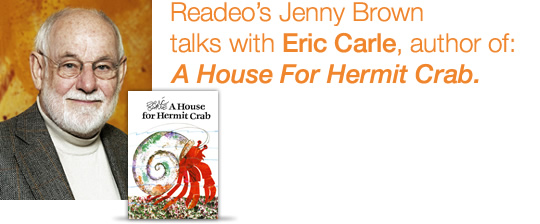


Congratulations to Eric Carle! He won a Lifetime Achievement Award last month from the Society of Illustrators in New York City. Here he talks about his start in children’s books, the unexpected metamorphosis of The Very Hungry Caterpillar, and our November featured book, A House for Hermit Crab.
You’ve said that you started out in advertising. Bill Martin Jr saw one of your ads and asked you if you would illustrate his manuscript, Brown Bear, Brown Bear, What Do You See? Is that how you got started in children’s books?
That was the moment when I realized, this is my true course in life. It had been suggested to me before that I might consider illustrating books for children, but it was really when I met Bill Martin Jr and worked on Brown Bear that I was set on fire. I became completely inspired and ever since have been making books for children.
Was it easier to write and illustrate a book yourself? Or did that present different challenges?
It presented challenges because I was first a visual person and was more comfortable making the pictures. But gradually, over time, I began to find my way. And now, although I have collaborated with others like Bill Martin Jr, I prefer to do both story and illustration.
Is it true that the star of The Very Hungry Caterpillar started out as a worm?
Yes, it is true. One day I was punching holes with a hole puncher into a stack of paper, and I thought of a bookworm and so I created a story called A Week with Willi the Worm. Then later my editor, who didn’t like the idea of a worm, suggested a caterpillar and I said “Butterfly!” And the rest is history.
You give a lot of good information at the end A House for Hermit Crab about the creatures he meets in his travels.
I am fascinated by animals and insects. I always have been ever since I was a child and my father took me for walks in the woods, lifted up the bark of a tree to find the creatures who lived underneath. My aim with my books is to entertain with the story and the pictures. And to include a little learning, a little knowledge as well. The learning part I always camouflage. It’s just one aspect, one dimension of the book.
How do you create a collage?
I make my collage illustrations using my own hand-painted tissue papers. I paint thin, translucent tissue paper with acrylics to create my ‘palette’ of colors and textures. I then organize them into color-coded flat files so that I have a stock of papers to work with. Using these painted papers, which I cut and tear and then glue down onto illustration board, I create the artwork.
We liked the spattery dots on the ocean floor in Hermit Crab. Did you flip your paintbrush to make those?
Yes, and sometimes I use the end of my paintbrush or a piece of carpet to create patterns and texture in my papers.
Do you think the story of Hermit Crab would give children courage if they had to move to a new home?
That would be very nice. Whether it is a move, or starting a new school, there are all kinds of transitions for children. I am particularly interested in the transition from home to school, as this was a challenging period in my own childhood. I hope my books will help to make transitions easier for children.

